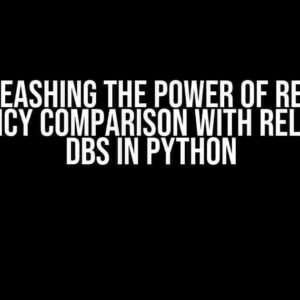Have you ever encountered the infuriating error “NoneType’ object has no attribute ‘split'” while calling a function from another Python file? You’re not alone! This error can be a real showstopper, leaving even the most seasoned Python developers stumped. But fear not, dear reader, for we’re about to embark on a journey to demystify this error and provide a clear, comprehensive solution.
What’s Causing the Error?
Before we dive into the solution, let’s briefly explore the root cause of this error. The “NoneType’ object has no attribute ‘split'” error occurs when you’re trying to call the split() method on an object that doesn’t exist or has no value, i.e., it’s of type None.
In the context of calling a function from another Python file, this error often arises when:
- The function is not properly imported or referenced.
- The function is not returning a value or is returning
None. - The function is not being called correctly.
Step 1: Verify Function Importation and Reference
Let’s start by ensuring that the function is properly imported and referenced. In your main Python file, make sure you’ve imported the function correctly:
from my_other_file import my_functionIn the above example, we’re importing the my_function from the my_other_file.py file. If you’re using a relative import, ensure that your files are structured correctly and you’re using the correct syntax.
Common Importation Mistakes
Don’t fall victim to these common importation mistakes:
- Missing or incorrect file name: Double-check that the file name and path are correct.
- Typos: Ensure that the function name is spelled correctly.
- Circular imports: Avoid importing functions from files that, in turn, import from your current file.
Step 2: Ensure Function Returns a Value
Next, verify that the function is returning a value. Open the file containing the function and check its implementation:
def my_function():
# some code here
return resultIn this example, the function my_function should return a value, which we’ll refer to as result. If the function doesn’t explicitly return a value, it will default to returning None, leading to our error.
Common Return Value Mistakes
Watch out for these common mistakes:
- Missing return statement: Ensure that the function has a return statement.
- Implicit return: Be aware that some functions, like list comprehensions, may implicitly return a value.
- Returning None intentionally: If you’re intentionally returning
None, ensure that you’re handling this scenario correctly in your calling code.
Step 3: Verify Function Call and Argument Passing
Now, let’s examine the function call and argument passing. In your main Python file, ensure that you’re calling the function correctly:
result = my_function('arg1', 'arg2')In this example, we’re calling the my_function function with two arguments, 'arg1' and 'arg2'. Verify that the function is defined to accept these arguments:
def my_function(arg1, arg2):
# some code here
return resultEnsure that the function definition matches the arguments you’re passing.
Common Function Call Mistakes
Beware of these common function call mistakes:
- Incorrect argument count: Ensure that the number of arguments passed matches the function definition.
- Argument type mismatch: Verify that the argument types match the function definition.
- Missing or extra arguments: Double-check that you’re not missing or passing extra arguments.
Step 4: Handle the Returned Value
Finally, ensure that you’re properly handling the returned value. If the function returns a value, you should assign it to a variable:
result = my_function('arg1', 'arg2')
if result:
# process the result
split_result = result.split(',')
# do something with split_result
else:
# handle the case where result is None or False
print("Error: Result is None or False")In this example, we’re assigning the returned value to the result variable. We then check if the result is truthy using an if statement. If it is, we proceed to call the split() method on the result. If not, we handle the error scenario.
Conclusion
By following these steps, you should be able to resolve the “NoneType’ object has no attribute ‘split'” error when calling a function from another Python file. Remember to:
- Verify function importation and reference.
- Ensure the function returns a value.
- Verify function call and argument passing.
- Handle the returned value correctly.
By being meticulous in your code and following these guidelines, you’ll be well on your way to resolving this error and writing more robust, error-free Python code.
Bonus Tips and Tricks
To take your Python skills to the next level, keep these bonus tips in mind:
- Use type hints**: Incorporate type hints to specify the expected return type and argument types, making your code more readable and maintainable.
- Implement error handling**: Anticipate potential errors and implement try-except blocks to handle them gracefully.
- Test your code**: Write comprehensive tests to ensure your code works as expected, and catch errors early on.
- Use a linter**: Utilize a linter to catch syntax errors, formatting issues, and other common mistakes.
- Debug your code**: Learn to effectively use the built-in debugger or a third-party tool to identify and fix errors.
| Troubleshooting Tip | Description |
|---|---|
| Print debug statements | Insert print statements to inspect variable values and function calls, helping you identify the error source. |
| Use the pdb module | Employ the built-in pdb module to step through your code, examine variables, and set breakpoints. |
| Analyze the error message | Carefully read the error message, as it often provides valuable information about the error’s location and cause. |
With these comprehensive steps and bonus tips, you’ll be well-equipped to tackle the “NoneType’ object has no attribute ‘split'” error and become a more proficient Python developer.
Frequently Asked Question
Hey there, code wizard! Ever encountered the pesky “NoneType” error when calling a function from another Python file? Don’t worry, we’ve got you covered!
What does the “NoneType” error mean in Python?
The “NoneType” error occurs when you’re trying to access an attribute (like a method or property) on an object that doesn’t exist, i.e., it’s of type “None”. This can happen when a function or method returns no value (i.e., “None”) and you’re trying to call another method on that non-existent value.
Why am I getting a “NoneType” error when calling a function from another Python file?
This often happens when the function you’re calling returns no value (i.e., “None”) and you’re trying to call another method on that returned value. Check your function definition in the other Python file and make sure it’s returning the expected value.
How can I troubleshoot the “NoneType” error when calling a function from another Python file?
Debug your code by adding print statements or using a debugger to check the value returned by the function. Verify that the function is indeed returning the expected value and not “None”. You can also try printing the type of the returned value using `print(type(returned_value))` to see if it’s indeed “NoneType”.
Can I avoid the “NoneType” error by checking for “None” before calling the method?
Yes, you can avoid the “NoneType” error by checking if the returned value is not “None” before calling the method. For example, `if returned_value is not None: returned_value.split()`. This way, you’ll only try to call the method if the returned value is not “None”.
What are some best practices to avoid the “NoneType” error in Python?
Some best practices to avoid the “NoneType” error include: always checking the return type of a function, using default values for optional arguments, and considering using type hints to specify the expected return type of a function.
There you have it, code wizard! With these tips, you’ll be well on your way to conquering the “NoneType” error and becoming a master of Python programming.


![Conquering the “Cannot get rid of ‘Make [field name] transient or serializable'” Warning from SonarLint on Intellij Conquering the “Cannot get rid of ‘Make [field name] transient or serializable'” Warning from SonarLint on Intellij](https://maleeq.hkhazo.biz.id/wp-content/uploads/sites/16/2024/07/conquering-the-cannot-get-rid-of-make-field-name-transient-or-serializable-warning-from-sonarlint-on-intellij-with-text-300x300.jpg)






